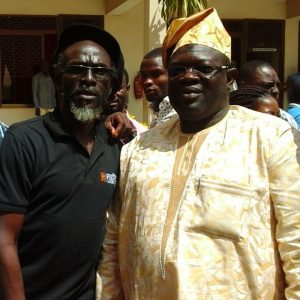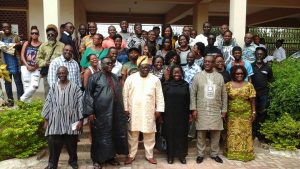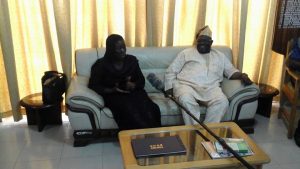Tourism in Ghana, The Northern Offer
There are certain striking features about the northern region. One of them is that a simple drive from one part of the region to the other is like a whole day’s trip. Tamale to Nalerigu and back or Tamale to Mole and back takes the better part of the day.
In fact the Northern Region of Ghana is the biggest region in the country occupying a third of the entire Ghanaian landmass. The region is a kaleidoscope of culture with the mix of Gonjas, Dagombas, Nanumbas, Mamprugus and other cultures and Tamale, the regional capital has been described as the fastest growing city in West Africa.
According to the Northern Regional Minister Alhaji Mumuni Limuna who is the fifty-second Administrative head of the region since the first colonial administrator of the region, the region offers immense tourism potentials that can be harnessed for national development from the revenues these potentials can generate.

Speaking during a visit by a delegation of officials of the Ministry of Tourism, Culture and Creative Arts and practitioners in the creative industries to the region, the Regional Minister was very vocal on the potentials of the region which includes the Mole National Park, the Nalerigu Scarps, the Larabinga mosque, the Mystery stone, the Salaga slave market, German cemetery and the rich cultural festivals of the people including the culinary based Afayaya which celebrates the legendary guinea fowl delicatessen.
Historical and cultural diversity
The Northern Region is made up of one metropolis, two municipalities and twenty three districts which are home to the Dagombas, Gonjas, Nanumbas, Mamprussis and Konkombas among others who all have rich historical and cultural heritages. The regional capital was formerly in Gambaga until the colonial administration moved it to Tamale at the start of the twentieth century.
Among the folk traditions is that of the legendary Ndewura Sumaila Jakpa, a Mende said to be founder of the Gonja kingdom having migrated from the remnants of the ancient Songhai Empire in current day Mali. Folklore has it that Ndewura Jakpa having fought many battles met no resistance when he got to Dagbon and so named the town as such which means cold. Another story has it that he felt cold due to the weather in the town hence the name.
Whatever the origin of the name, from Dagbon the great Ndewura Jakpa developed a system of administration based on chieftaincy since the natives who were of Guan origin had no chieftaincy system in place. A notable tour guide in the region Cosmos Mumuni has it that as a result of their migrations, Jakpa and his warriors had lost their language so they adopted the language of the natives over who he established the chieftaincy system of governance.

Tourist attractions of the region
The tourist attractions in the Northern region range from architecture, culture to eco-tourism. The aesthetic design of the round houses, the landscaping and use of traditional building materials where in certain areas the blood of animals is used for painting the buildings; the rich culture of the people from their greetings to their dressings, festivals and cuisine (the deputy regional minister A.B.A Fuseini has dared anyone to prove any other region more hospitable than the northern region); and then the awe inspiring sites there.
The sites include the Mole National Park which without a doubt is comparable to any other site anywhere in the world in terms of the diversity of the flora and fauna there. The new Zaina Eco Lodge built exclusively from local materials but with a world class touch and the nearby Mognori Eco Village also add to the allure of the Park. The Gambaga or Nankpanduri Scarps as they are called now also provide breath taking views and huge potentials for trekking and paragliding. While in Nalerigu, on can’t skip the Nalerigu Defence Wall built to ward off slave raiders. The Larabanga mosque and the Mystery stone with over six hundred years of history behind them are other must see tourist sites.

For the historically inclined tourist, the Salaga slave market is a site you don’t want to miss out. There is a museum that houses some artifacts from the era as well as the slave well where water was drawn to bath the slaves.
Rebranding Tourism with Culture and Creative Arts
The visit by the Minister of Tourism, Culture and Creative Arts Mrs. Elizabeth Ofosu-Agyare and her delegation which included actors, musicians and other creative arts practitioners is part of the ministry’s agenda of promoting domestic tourism.
According to Mrs. Elizabeth Ofosu-Agyare, her ministry is rebranding tourism in Ghana with culture and the creative arts to boost both domestic and international tourism. Tweets, postings on Facebook and other social media platforms by the stars of their presence in the north will create awareness among their fans to drive both domestic and international tourism. She noted that in other countries, tourism is a huge contributor to their G.D.P and Ghana intends to follow that path of development.
As part of the visit, the delegation paid courtesy calls on traditional leaders and also visited some of the numerous tourist attractions in the region. The delegation visited the Yagbonwura Tuutnba Boresa Jakpa Sulemana, Kpenbiwura Naa Ncho Bore, Nyelimbolgu Naa Yakubu Andani Dasana, the Kampapuya Naa Abdulai Andani and Nayiri Blaa Bohogo Mahama.
They also met with metropolitan, municipal and district chief executives and discussed ways of harnessing the tourism potential in their regions for the benefit of their constituents and the nation at large. Members of the delegation included Pascaline Edwards, Ama Odomaa, Roselyn Ngissah, Eunice Banini and Irene Opare. Ekow Smith Asante, Dan Tei Mensah, Rev Eddie Coffie President of the Actors Guild, Kalifa Adam Kalifa President of the Zango Film Makers Association of Ghana, Joe Wizzy the Greater Accra regional organizer of MUSIGA, Ras Caleb Appiah, B.B. Jnr northern regional sensation Abu Sadiq, gospel songstress Annette Danso, Ahuma Bosco Ocansey, Director of Special Projects and Communications of MUSIGA, Alhaji Braimah, President of the National Dressmakers and Tailors Association and Francis Glover of the Ghana Cultural Forum were also on the trip.

The ministry intends to leverage the star power of the celebrities to promote domestic tourism. As the Northern regional minister says it’s essential since there are Ghanaians who are more familiar with the tourist attractions of Washington, London, New York and Berlin than with what we have here in Ghana.
With five flights a day from the Tamale Airport to other parts of the country, the accessibility of the region is greatly enhanced in addition to the existing road and water transportation options. So for your next holidays, go on and check out the Northern region and you will be glad you did.



